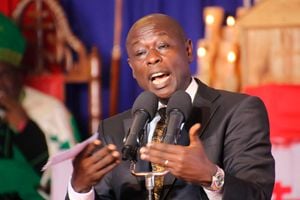Why ‘bottom-up’ is the cure for inequality

President William Ruto takes breakfast at a kibanda in Mandera Town during a past campaign trip. At the heart of the Bottom-Up Economic Transformation Agenda is the Hustler Fund. With more than 18 million subscribers so far, it offers one of the lowest interest rates in the country.
A recent revelation that Kenya’s wealthiest-four individuals own more than nearly half of the population is a serious indictment of our economic system, which has failed to bring about income distribution and narrow the inequality gap.
A recent Oxfam report says Kenya has seen an increasing extreme wealth and increasing extreme poverty, driven by low taxes on the rich, the main owners of the factors of production, including land and capital.
These incentives have been implemented through tax breaks and holidays while burdening the poor with consumption taxes on food, fuel and basic commodities.
Pro-rich economic policies are a fundamental argument of trickle-down economics, founded on the premise that ‘if you feed the horse enough oats, some will pass through to the road for the sparrows’. That means tax privileges for wealthy individuals and companies eventually trickle down to those in lower income brackets.
However, recent sharp increases in the income inequalities call for a ‘trickle-up’ effect. In this regard, President William Ruto’s bottom-up economic model is the answer.
Promoting policies that directly benefit lower-income individuals, it seeks to end consumption subsidies, which constituted a significant percentage of gross domestic product (GDP), and instead lower input prices and expand our productive capacity.
Hustler Fund
At the heart of the Bottom-Up Economic Transformation Agenda is the Hustler Fund. With more than 18 million subscribers so far, it offers one of the lowest interest rates in the country.
It has cushioned informal business people, the biggest employers, against predatory lenders. It has already disbursed Sh14.8 billion in loans and accrued Sh740 million savings with repayments at 50 per cent of total borrowings.
By easing access to credit, the fund will create employment and increase the aggregate demand and, in extension, the national income. Given an effective buffer against external shocks, it promises to lift many out of poverty.
Reyia is an economist in the public service. [email protected].




